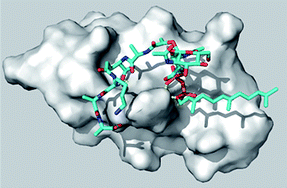Antibiotic activities of host defense peptides: more to it than lipid bilayer perturbation
Abstract
Defensins are small basic amphiphilic

* Corresponding authors
a
Institute of Medical Microbiology, Immunology and Parasitology – Pharmaceutical Microbiology Section, University of Bonn, Meckenheimer Allee 168, Bonn, Germany
E-mail:
sahl@microbiology-bonn.de
Fax: +49-228-73-5267
Tel: +49-228-73-5272
b
Centre of Microbial and Plant Genetics (CMPG), Katholieke Universiteit Leuven, Kasteelpark Arenberg 20, Heverlee, Belgium
E-mail:
Karin.Thevissen@biw.kuleuven.be
Fax: +32 16 32 19 66
Tel: +32 16 32 96 88
Defensins are small basic amphiphilic

 Please wait while we load your content...
Something went wrong. Try again?
Please wait while we load your content...
Something went wrong. Try again?
M. Wilmes, B. P. A. Cammue, H. Sahl and K. Thevissen, Nat. Prod. Rep., 2011, 28, 1350 DOI: 10.1039/C1NP00022E
To request permission to reproduce material from this article, please go to the Copyright Clearance Center request page.
If you are an author contributing to an RSC publication, you do not need to request permission provided correct acknowledgement is given.
If you are the author of this article, you do not need to request permission to reproduce figures and diagrams provided correct acknowledgement is given. If you want to reproduce the whole article in a third-party publication (excluding your thesis/dissertation for which permission is not required) please go to the Copyright Clearance Center request page.
Read more about how to correctly acknowledge RSC content.
 Fetching data from CrossRef.
Fetching data from CrossRef.
This may take some time to load.
Loading related content
